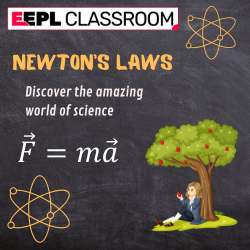Introduction to Newton’s Laws of Motion
Isaac Newton, a prominent physicist and mathematician of the 17th century, is renowned for his monumental contributions to the field of physics. Among his most significant achievements are the three laws of motion that form the foundation of classical mechanics. These laws not only laid the groundwork for the study of motion but also provided a coherent framework for subsequent developments in physics. Understanding Newton’s laws of motion is particularly vital for class 9 students, as it aids in grasping the fundamental principles that govern the movement of objects.
Newton’s first law of motion, often referred to as the law of inertia, states that an object remains at rest or in uniform motion unless acted upon by an external force. This principle elucidates the concept of inertia and sets the stage for understanding how forces influence the state of motion of an object. The second law expresses the relationship between force, mass, and acceleration, encapsulated in the formula F=ma. This equation provides crucial insights into how an object will accelerate in response to applied forces, a concept that is foundational for comprehending dynamics in physics.
The third law of motion states that for every action, there is an equal and opposite reaction. This critical law highlights the interaction between two objects when forces are applied, showcasing that forces always come in pairs. Collectively, Newton’s laws of motion serve as essential tools for analyzing and predicting the behavior of objects, forming the cornerstone of classical mechanics. By exploring these laws in detail, students can forge a deeper understanding of motion, enabling them to apply these concepts in various scientific contexts and real-world scenarios. This knowledge will not only enhance their academic understanding but also engage them in discerning the mechanics of their surrounding environment.
The First Law of Motion: Law of Inertia
Newton’s First Law of Motion, often referred to as the Law of Inertia, states that an object at rest will remain at rest, and an object in motion will continue moving at a constant velocity unless acted upon by a net external force. This fundamental principle plays a critical role in understanding how forces interact with objects, making it essential for class 9 students studying physics.
Inertia, the tendency of an object to resist changes to its state of motion, is a key aspect of this law. The greater the mass of an object, the greater its inertia. For example, a heavy truck requires more force to change its motion compared to a small bicycle. This principle is observable in everyday life; when a bus suddenly stops, passengers lurch forward due to their inertia, emphasizing the law’s relevance in dynamic states.
Another common example of the Law of Inertia can be observed when a basketball is rolled across a gym floor. The ball continues in motion until friction and other forces, such as air resistance, gradually impede its path, causing it to come to a stop. This scenario illustrates that even a small force, like friction, can affect motion in a predictable manner, affirming Newton’s assertion on objects in motion.
This law is not just applicable in dynamic situations but also in static states. For instance, a book resting on a table will remain stationary until an external force, such as a push, is applied. Understanding these principles enables class 9 students to appreciate the foundational concepts of mechanics and how they govern the motion of everyday objects in both still and moving scenarios.
The Second Law of Motion: Law of Acceleration
Newton’s Second Law of Motion, often referred to as the law of acceleration, is a critical principle in the study of mechanics, particularly for students in class 9. This law establishes the fundamental relationship between the force applied to an object, its mass, and the resulting acceleration. Mathematically, it is expressed by the equation F = ma, where F is the force applied, m is the mass of the object, and a is the acceleration produced. This equation highlights that the acceleration of an object is directly proportional to the net force acting upon it and inversely proportional to its mass.
To further comprehend this concept, consider the scenario of pushing a car. If a person exerts a force of 500 N (Newtons) on a stationary vehicle with a mass of 1000 kg, we can calculate the acceleration using the formula: a = F/m. Substituting the values gives us a = 500 N / 1000 kg, resulting in an acceleration of 0.5 m/s². This example clearly illustrates how a specific force leads to a measurable acceleration, depending on the mass of the object being acted upon.
Real-world applications of Newton’s second law are abundant and vary across different fields. In sports, for instance, athletes use this principle to maximize their performance—sprinters leverage the force applied during their start to achieve rapid acceleration. Additionally, engineers apply this law in vehicle design to ensure safe acceleration and stopping distances in automotive safety tests. In the study of physics, class 9 students must understand that every force produces an effect, and recognizing this dynamic allows them to predict and analyze motion effectively.
Understanding the implications of this law is crucial for grasping more advanced concepts in physics, as it serves as the foundation for further exploration in mechanics and kinematics.
The Third Law of Motion: Action and Reaction
Newton’s Third Law of Motion is a fundamental principle in the study of mechanics, particularly significant for students in their class 9 curriculum. This law articulates that for every action, there exists an equal and opposite reaction. It underscores the intrinsic nature of forces in interactions between objects, emphasizing that forces always occur in pairs. When one object exerts a force on another, the second object exerts a force of equal magnitude but in the opposite direction on the first object.
Daily life presents numerous instances illustrating this law in action. A classic example is walking. When a person walks, they push against the ground with their feet. According to Newton’s Third Law, the ground simultaneously pushes back against the person with an equal and opposite force. This reaction force is what propels the individual forward, demonstrating the application of Newton’s laws of motion in a simple yet profound manner.
Another instance can be observed while swimming. As a swimmer pushes water backwards with their hands and feet, the action of pushing the water creates a reaction force that propels the swimmer in the opposite direction. This interaction highlights the interdependence of action and reaction forces, reinforcing the learning objectives set out in class 9 science curriculum.
Understanding this law expands beyond mere examples. It is essential in various physical phenomena, including propulsion systems in vehicles, where engines push exhaust gases backward, resulting in forward motion due to the reaction force. By recognizing how Newton’s Third Law operates in multiple contexts, students can cultivate a deeper comprehension of the interrelations between different physical forces and their outcomes. This knowledge serves as a cornerstone for further exploration into the realm of mechanics, embodying essential principles for aspiring scientists and engineers.
Real-World Applications of Newton’s Laws
Newton’s laws of motion play a pivotal role in a multitude of real-world applications, particularly in technology and engineering. Understanding these fundamental principles is essential for students in Class 9 as they begin to explore the implications of motion in everyday life. From the design and functionality of vehicles to the biomechanics of sports, the influence of these laws is widespread and profound.
One significant application of Newton’s laws is in the automotive industry. The first law, also known as the law of inertia, helps engineers design vehicles that can effectively maintain their motion unless acted upon by an external force, such as friction or braking. This principle informs the creation of advanced systems like anti-lock braking systems (ABS), which enhance vehicle safety by preventing wheel lock-up during sudden stops. Similarly, the second law, which relates force, mass, and acceleration, is crucial in determining how quickly a car can accelerate or decelerate, thereby influencing design choices in engine power and overall vehicle dynamics.
In the realm of sports, athletes utilize the concepts derived from Newton’s laws to improve their performance. For example, when a soccer player kicks a ball, the force applied dictates the ball’s acceleration, shape, and distance traveled—demonstrating the direct correlation with the second law of motion. Coaches and trainers frequently analyze these motions to optimize techniques, enhancing player performance and reducing injuries. Additionally, sports equipment design, from tennis rackets to bicycles, is meticulously engineered using these principles, ensuring that athletes can maximize their physical capabilities in a safe manner.
In conclusion, the practical implications of Newton’s laws of motion are significant. Recognizing how these laws shape various technological and engineering services provides a concrete understanding for Class 9 students, illuminating the relevance of these principles in their daily lives.
Experiments and Activities Demonstrating Newton’s Laws
Understanding Newton’s laws of motion, particularly for class 9 students, can be greatly enhanced through hands-on experiments and activities. Engaging in practical demonstrations allows students to observe the principles of mechanics in action, leading to a more profound comprehension of these fundamental concepts. Below are several engaging activities that teachers and students can conduct together.
One practical experiment to illustrate Newton’s First Law, also known as the law of inertia, involves a simple setup with a toy car and a flat surface. Place the toy car at rest on the surface and then give it a gentle push. Students will notice that the car only starts to move when an external force is applied. This activity emphasizes that an object at rest stays at rest until acted upon by an unbalanced force.
For Newton’s Second Law, which states that acceleration is produced when a force acts on a mass, students can try a balloon rocket experiment. Secure a balloon to a straw that is threaded onto a piece of string. As the balloon is inflated and then released, students will observe how the propulsion of the air being expelled leads to a change in motion. The greater the force applied through the air, the faster the balloon accelerates, demonstrating the relationship between mass, force, and acceleration.
To illustrate Newton’s Third Law—the principle that for every action, there is an equal and opposite reaction—students can participate in a simple egg drop challenge. By varying the height from which an egg is dropped and observing how it behaves upon impact, students will learn that the force exerted on the egg reacts with equal force, influencing whether it breaks or not. This activity fosters critical thinking and prompts discussions about force and impact.
These experiments align with the curriculum for class 9 students and serve to reinforce the principles articulated by Newton’s laws of motion. Through these engaging activities, students not only comprehend mechanical concepts but also develop a keen interest in physics. Inviting inquiry and exploration will ultimately lead to a better understanding of the physical world around them.
Common Misconceptions about Newton’s Laws
Understanding Newton’s laws of motion is fundamental for students in class 9 as they form the basis of classical mechanics. However, many students hold misconceptions about these laws, which can impede their grasp of the subject. One common misunderstanding is that Newton’s first law, often referred to as the law of inertia, implies that a force is always required to keep an object in motion. In fact, the law states that an object in motion will remain in motion unless acted upon by an external force. This means that a moving object does not require a continuous application of force to maintain its velocity; it is the absence of forces that allows it to continue moving.
Another prevalent misconception regards the second law of motion, which relates force, mass, and acceleration. Students sometimes believe that heavier objects fall faster than lighter ones due solely to their mass, overlooking the role of gravitational force acting equally on all objects. In reality, while the mass influences the acceleration when a net force is applied, all objects in free fall accelerate at the same rate, irrespective of their mass, when air resistance is negligible.
Furthermore, when it comes to Newton’s third law, students may think that action and reaction forces cancel each other out. While it is true that these forces are equal in magnitude and opposite in direction, they act on different objects. This means they do not cancel each other; rather, they enable interactions between bodies, which can lead to various outcomes, such as motion alterations.
By addressing these misconceptions early, educators can facilitate a clearer understanding of the newton’s laws of motion for class 9 students, helping them to build a solid foundation in physics. Recognizing these corrections is essential for enhancing students’ comprehension and application of these laws in real-world scenarios.
The Legacy of Newton’s Laws in Modern Science
Newton’s laws of motion, established in the 17th century, continue to serve as a cornerstone in the field of physics, particularly for students in class 9. These principles not only elucidate the relationship between the forces acting upon an object and its motion, but they also lay the groundwork for various scientific explorations and technological innovations. The fundamental insights provided by these laws have transcended their original context, fostering advancements in multiple scientific domains.
To begin with, Newton’s first law, often referred to as the law of inertia, has profound implications in both classical mechanics and engineering. It establishes that an object at rest will remain at rest, while an object in motion will continue in its motion unless acted upon by an external force. This principle is vital for understanding motion in a wide array of contexts, from the design of vehicles to the analysis of atmospheric phenomena. Engineers frequently rely on this concept when constructing safety features in automobiles or when studying the trajectories of various projectiles.
Furthermore, the second law, which introduces the relationship between force, mass, and acceleration, has inspired a myriad of calculations within dynamics. In class 9 curriculum, students learn to apply this law to real-world scenarios, enhancing their comprehension of how forces influence the behavior of objects. This understanding is not only crucial in theoretical studies but also in practical applications such as robotics, aviation, and even astrophysics.
Lastly, the third law states that for every action, there is an equal and opposite reaction. This principle is evident in countless activities, including propulsion systems in rockets and everyday activities like walking. By embracing Newton’s laws of motion, emerging scientists and engineers are equipped with the tools necessary to innovate and push the boundaries of what is technically feasible. Thus, the legacy of Newton’s principles remains vibrantly alive in modern science and technology, shaping the future of mechanical understanding.
Conclusion: The Importance of Understanding Newton’s Laws
Understanding Newton’s Laws of Motion is pivotal for Class 9 students as it lays the groundwork for comprehending the fundamental principles of mechanics. These laws not only explain how objects move but also provide insights into the interactions between forces and motion. The first law, emphasizing inertia, helps students grasp the idea that an object will remain in a state of rest or uniform motion unless acted upon by an external force. This principle is observable in everyday life, such as when a car suddenly stops, causing passengers to lurch forward.
The second law quantifies this relationship by demonstrating how force, mass, and acceleration work together. It reinforces the concept that the acceleration of an object depends on the net force acting upon it and its mass, which is critical for understanding various applications in engineering and technology. For instance, when designing vehicles or elevators, engineers must apply these principles to ensure safety and efficiency.
Lastly, the third law illustrates the action-reaction principle, highlighting that for every action, there is an equal and opposite reaction. This law is vital for understanding how rockets propel themselves into space or how athletes utilize their ground reaction forces to enhance performance.
In summary, exploring Newton’s Laws of Motion is not merely an academic exercise for Class 9 students; it nurtures a deeper awareness of the physical world. By acknowledging the profound relevance of these principles in various real-life scenarios—from sports to engineering—students are encouraged to cultivate curiosity about physics. This foundational knowledge equips them with critical thinking skills, propelling them toward further studies in science and mechanics, ultimately contributing to their understanding of the complex phenomena that govern the universe.











